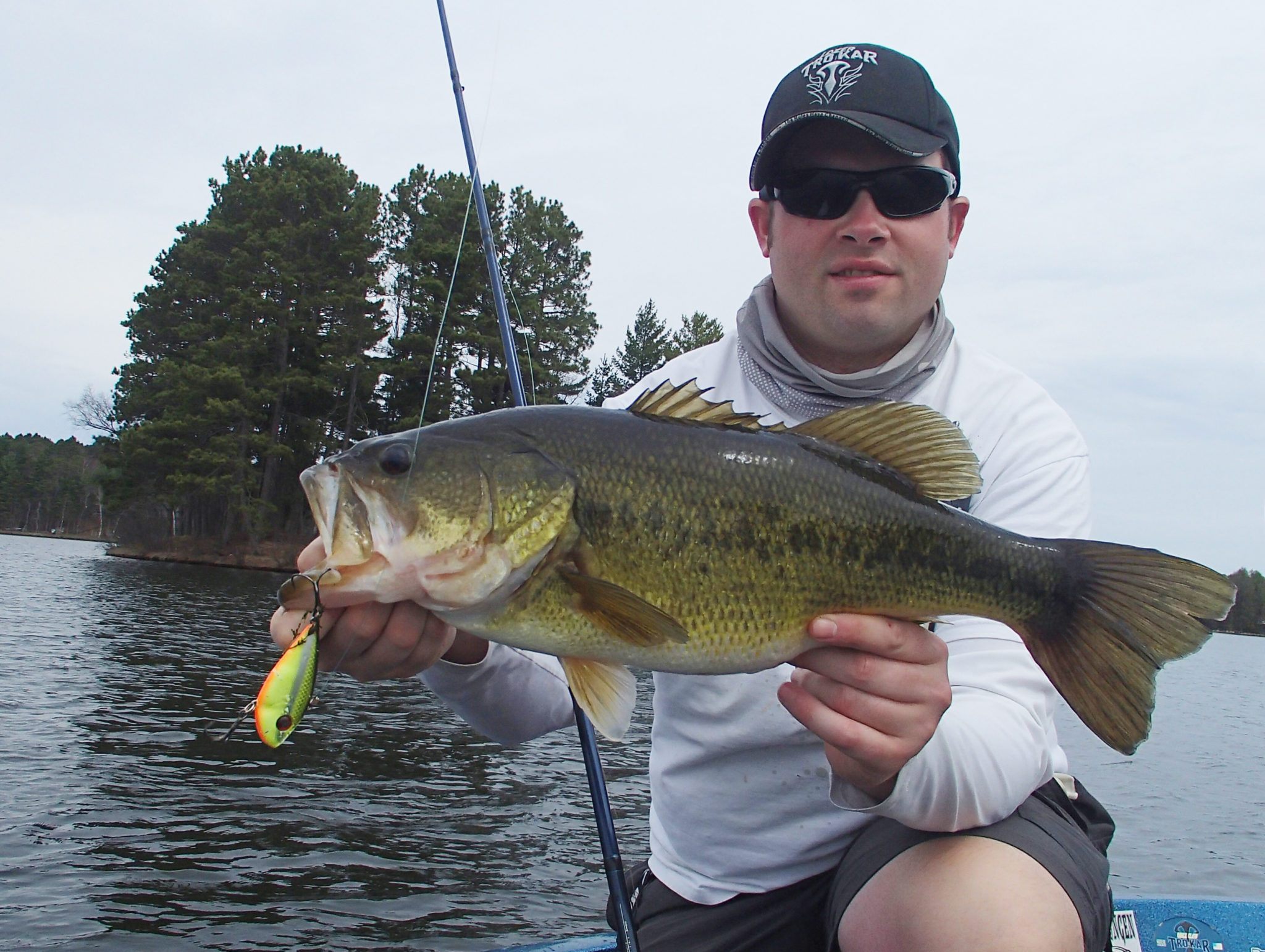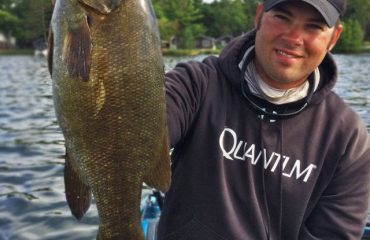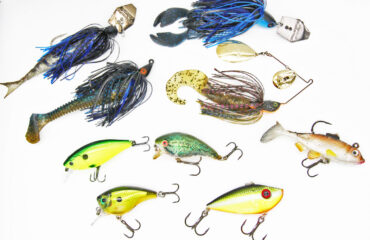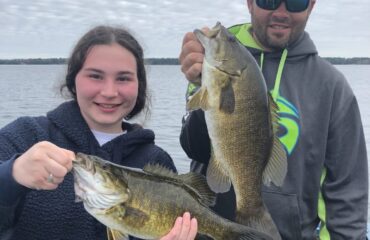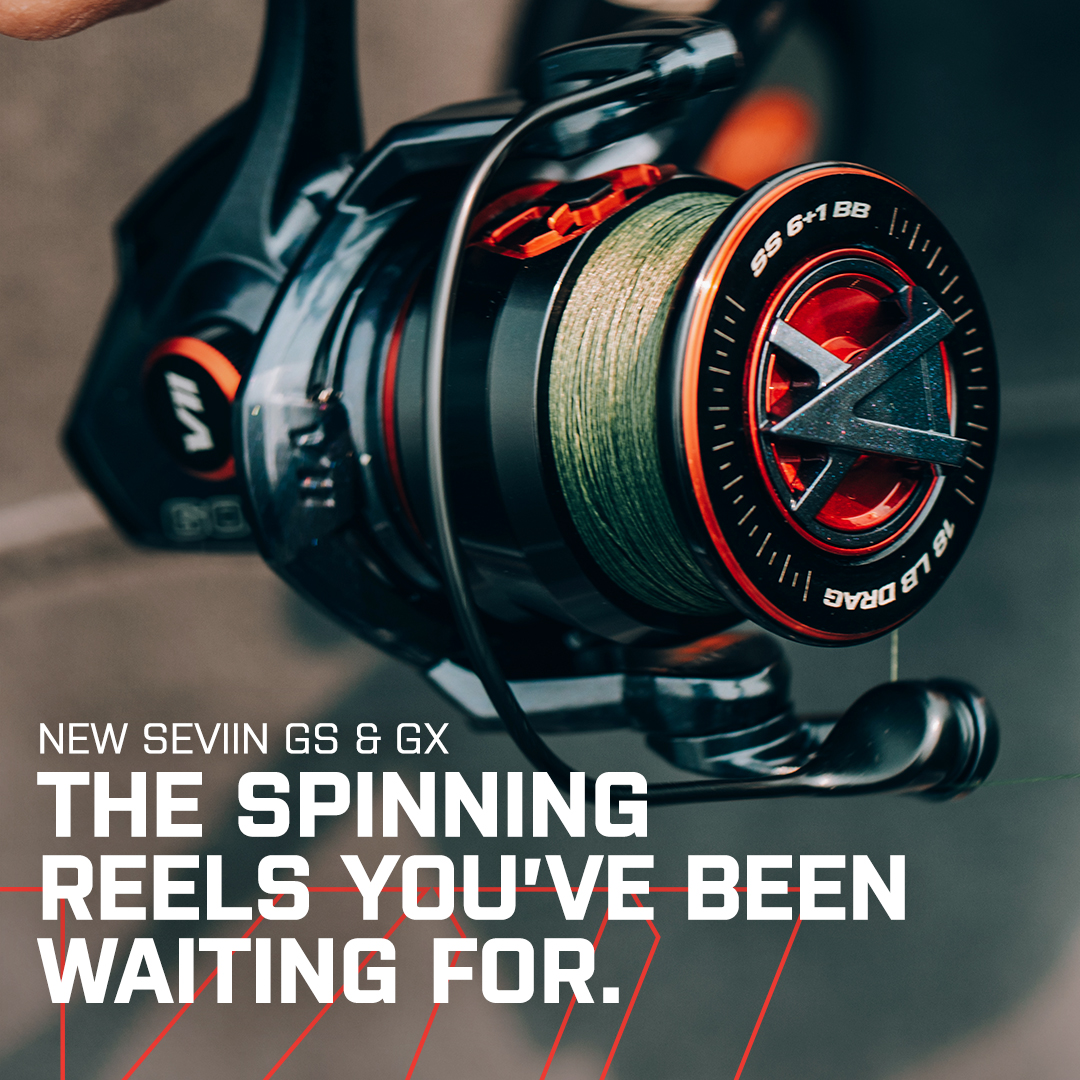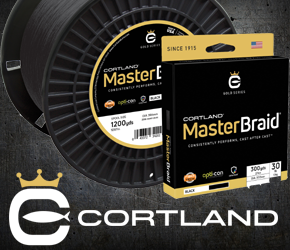No Weeds? No Problem Largemouth Bass
By Andrew Ragas
Cold spring often follows a very cold winter, and this translates into a season of delayed growth. Late ice-out, cold water temperature, and lack of sunlight are preventing the growth of new weeds. Lack of greenery in the shallows means there will not be any cover and rich oxygen for largemouths and other shallow-dwelling species. Consequently, bass will be favoring other habitats and forms of cover due to their adaptability.
The success of early spring largemouth bass fishing in the northwoods revolves around seeking shallow cover such as wood and weeds, and warming water temperatures. In conjunction with ample amounts of daytime sunlight, it triggers an explosion of new weed growth, leading to a mass migration of largemouths invading the shallows to set up for the spawn. Males move in first, followed by females. Ample new cover, ideal water temperature, and full moon influence their arrival in shallow water. In most years, this is to be expected. In recent years, it hasn’t happened and we’ve had to adjust our own fishing locations just like largemouths do.
When new weed growth fails to establish during the month of May, largemouths seek and favor alternative habitats and sources of cover. This has become the scenario and common pattern on many lakes these past several springs, with the shallow weed bites delayed, only beginning in early June.
No shallow weed growth in spring? No problem for the highly adaptable behavior of largemouth bass.
Experts in Adaptation
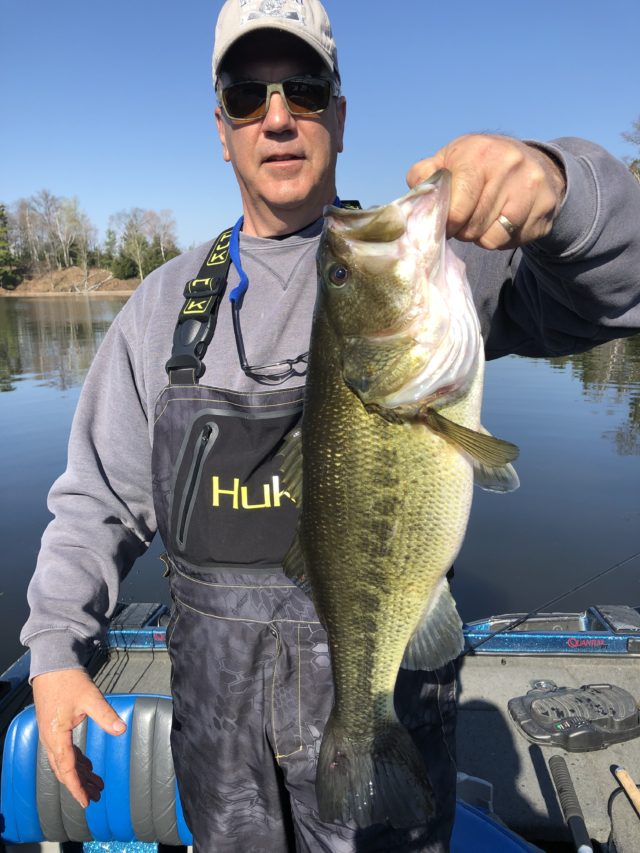
Guide customer, John Brophy of Rhinelander WI, scores a big pre-spawn largemouth bass from fishing an early-season backwater area. A black and blue swim jig with a Missile Baits D-Bomb trailer pitched into wood cover took this northwoods giant.
Largemouths are experts in adaptation and acclimation, often overcoming drastic environmental changes and adapt to new surroundings to be successful. They are resourceful with their habitat, using every form of natural and man made cover to their benefit. They are hearty, spawn successfully with high recruitment, and physiologically adept, making them a dominant predator in many fisheries. When other species suffer due to changes in the lake’s fishery or their overharvest, largemouths always fill the biomass.
In addition to habitat and cover adjustments, largemouths do not limit themselves to specific prey types either. Unless there is stunting and overpopulation, voracious appetites enable them to survive and achieve excellent growth rates and body weights in nearly every fishery. They prey on a number of fish species, insects, invertebrates, and amphibians. A non-picky appetite allows them to maintain a secure and healthy lifestyle.
Another critical adaptation is their ability to withstand great fluctuations in water temperature. Largemouth can tolerate lower concentrations of oxygen and PPM’s, which is very common on all lakes in early spring before green vegetation sprouts.
No Weeds, No Problem
Springtime usually brings warming weather and water temperatures. A lively and growing ecosystem then follows suit. When warming weather isn’t arriving, the ecosystem stalls and growing season delays. Largemouths that invade the shallows to feed and find warming waters will seek alternative habitats.
No weeds, no problem. Experts in finding and settling into their new surroundings, largemouths will gravitate to a variety of shallow cover and habitats when weed growth is lacking.
Reeds and Cattails – Left-over from the previous year, old stalks and remnants of this shallow plant are re-used every spring and provide largemouth lots of cover and ambush points for feeding. Located near shore, and protruding out from shorelines, these structures are well-built, and often grow in 5 ft depth or less. Sand bottoms and their exposure to sun are a benefit for heat conductivity. Reeds and cattails have the potential to also attract bluegills, sunfish, and other baitfish, making them very good bass habitat and obvious casting targets.
Laydowns, Stumps, and Trees – Wood is abundant, and the most favored cover available on many mesotrophic and eutrophic bass lakes. They are the best conductors of heat and provide protection to fish, thus attracting a cornucopia of life that will settle nearby. Located near shore and potentially extending into deeper water, the best wood cover relates to bays, backwaters, and bogs. The largest and most complicated concentrations of submerged wood will often hold several bass.
Backwaters, Channels, Inflows – The fertile backwater systems, marshes, side channels and thoroughfares of drainage lakes lead hungry largemouths to an awakening oasis of underwater life. These rich habitat waterways warm rapidly, and attract largemouth that come for feeding and spawning. While its main lake areas remain frigid, many gamefish species are attracted to these areas in early spring.
Emergent Lily Pads – The submerged root systems and sprouting stalks of lily pads could be the only establishing greenery in the shallows. Lily’s begin growing as soon as ice cover melts. Like any vegetation, sunlight accelerates its growth, but what separates pads from other weed species is their growth spurt begins early. Most common in shallow bays and pockets with soft bottom, they offer rich underwater oxygen content while being the only plant life growing. They are largemouth magnets due to oxygen production, as well as offering meandering jungles of cover.
Bogs and Tamarack Swamps – These brush shoreline areas and swamp lands are most common on drainage lakes and heavily vegetated eutrophic lakes. Usually flooded from high water, shoreline brush and bog bushes are money spots for largemouth, providing canopies and overhead cover. These are the first areas I will visit and jig fish on lakes that have this form of habitat.
Man-made cover – Every lake with shoreline development has man-made cover and structures built near shore and above the surface. Largemouths will always gravitate to piers, boat houses, fish cribs, brush piles, and rip-rap shorelines for early season feeding and spawning. Not every pier is created equally. The best ones are permanent structures that stay in water year-round, featuring wood pillars and dark shade underneath. Largemouths utilize piers and boat houses in the same mannerisms as they do with any other forms of wood cover. Always remember to fish the piers with precision skipping and pitching methods.
These alternative habitats exist on every largemouth fishery. Finding them requires nothing more than visual observation while on the water and studying the layout of the terrain. When visiting a particular body of water for the first time, Google maps will be most helpful in identifying likely near-shore targets first.
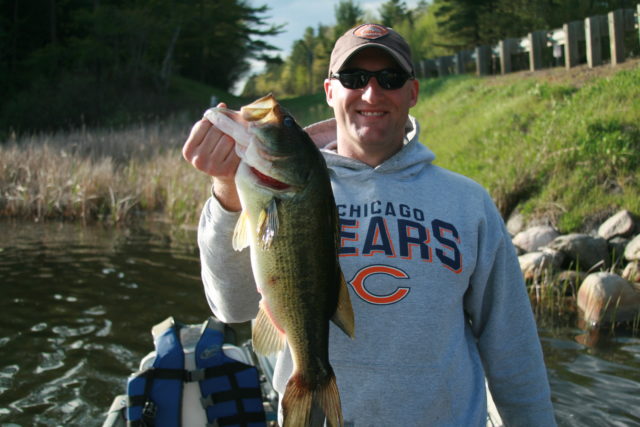
Friend and fishing partner, Jacob Saylor, holds an early spring 5 pounder. Weed growth was lacking during this spring, and alternative cover held big largemouth.
Largemouth Extraction
Shallow water cover fishing and largemouth extraction calls for power fishing with heavier rod and reel set-ups and braided lines. St. Croix Rods offers a technical and bass-centric selection specific models, actions, and lengths in the Bass-X, Mojo Bass, Legend Tournament, and Legend-X lineups. My personal picks for this early season target shooting is the Mojo Bass and Legend Tournament Dock Sniper, a 7 ft, heavy action all-purpose cover extractor. If seeking a rod that can handle it all, and is suitable under any budget, the Bass-X BXC71MHF is another suggested recommendation.
With casting targets abound, the major strategy will be pitching and flipping jigs and plastics into the cover. If you plan to cover water throughout shallow bays and along shorelines, the secondary strategy will be casting with search lures.
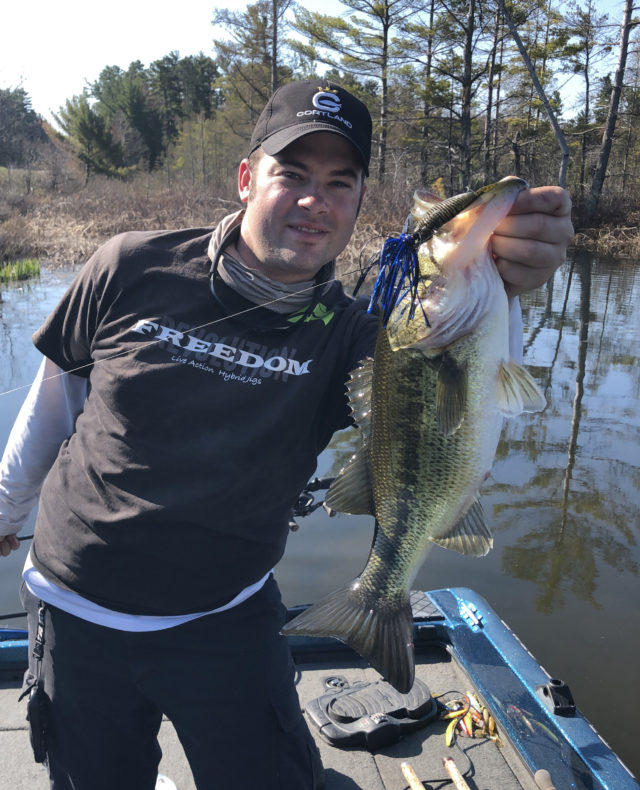
Black and blue jigs are synonymous with largemouth fishing, and the author’s favorite year-round in swimming, casting, and pitching & flipping head designs.
When largemouth hold to cover, go target fishing. Pitching and flipping weedless jigs in combination with craw and creature trailers such as Bizz Baits Bizz Bugs and Killer Craws, creature baits that includes YUM Wooly Bugs and Missile Baits D-Bombs, and slither rigs gets to big largemouths that bury themselves into jungles of wood, pads, and near-shore cover. The creature bait lure category encompasses a major variety of shapes and styles from several brands. Many of them will work as well. All of my flipping stick and heavy action casting setups are 6 ft 10” and longer rods, spooled up with 20 lb. and 30 lb. Cortland Masterbraid, and all new 50 lb. Silent Flip for jungle and wood extraction. Reels featuring a flipping switch aid in pitching accuracy, enabling you to land jigs into openings and within inches from where big largemouth could ambush. I still fish with my old, original Quantum Accurist PT’s that are over 10 to 15 years old. These models were popularized by legendary flipper and pitcher, Gary Klein. 7.0;1 gear ratio reels and higher are a must for quick hook-sets, power, and high frequency line retrieve.
Want to finesse your way with medium heavy action spinning gear such as St. Croix’s 7ft 1″ MH Legend Tournament or Mojo Bass, also? Sure, a weightless tube, and Texas rigged lizard or stickbait such as a 5” Kalin’s Wac-O worm in Baby Bass can succeed. Run 15 or 20 lb. Masterbraid as your reel’s main line, and attach a 3 ft. section of 12 or 16 lb. fluorocarbon leader for stealth as well as abrasion resistance. Size 30 or larger spinning reels will aid in line retrieve, plus have the best drag systems in the event you connect with a heavy line puller.
Casting with search lures is always plan-B strategy, and common when covering water and the boat is slowly encroaching flipping and pitching targets. Ripping and burning chatterbaits through the shallows such as the Z-Man Freedom Chatterbait, in my favorite black and blue model, rigged with paddletail and craw trailers triggers exhilarating strikes.
While pitching and flipping with heavy heads excels for bottom-oriented bass, swim jigs are designed to be cast and retrieved high in the water column. Lighter in weight, with head a design to cut through the water, they can be swum through current, vegetation, wood, rocks, and wherever baitfish and prey lurk.
The swim jig’s combination of density, compact size, and high hooking percentage caters best to being a swimming presentation. It becomes most effective paired with a trailer.
Swim jigs score huge numbers of fish because when perfectly rigged, with correct color combination paired with trailer, it can be utilized as a power and finesse presentation. Cone shaped heads will empower you to rip and power the jig through dense cover, with thin brush guard maintaining a weedless package. Trailers are the business end of a swim jig, and play a more important role than the jig itself. Trailers are what ultimately trigger strikes. It’s always important to mix and match between the different variables of tail action, size, color combination, and how it triggers fish. There are so many potential trailer styles to consider, but I always fish with baits that have previously worked for me as standalone lures (a rig of its own, by itself).
Looking to cover water even quicker and fish more aggressively? Burning lipless crankbaits such as Strike King Red Eye Shads and a Rat-L-Traps through shallow bays and parallel to shorelines entices aggression and reactionary strikes. This is the best cold water early season tactic.
Subtler presentations like swimming 3.8” Kalin’s Sizmic Shad paddletails rigged on weedless Freedom Tackle Hydra heads through emerging vegetation scores giants. So too will soft swimbaits such as 3” Storm WildEye Shiners. While everyone else is throwing their expensive swimbaits, I’ll throw my cheap baits and catch more bass. Downsized swimbaits represent a new, overlooked way of catching big largemouth. It’s also a potent presentation that has not yet been exploited by the masses to catching largemouth bass during the early spring season. They are an ideal early spring alternative when more seasonal power fishing techniques fail.
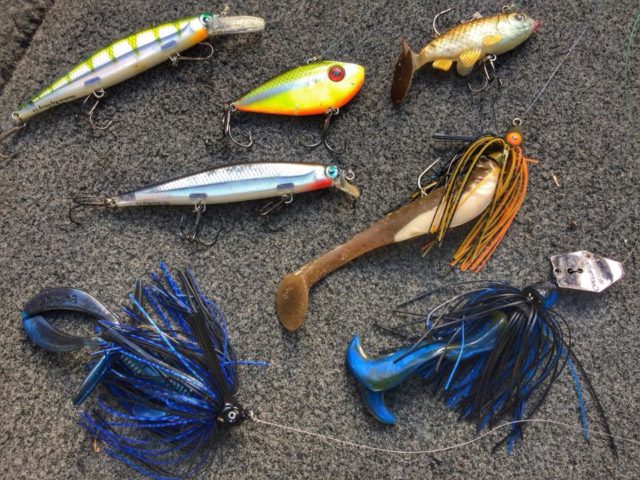
Shallow water cover fishing and largemouth extraction calls for power fishing with heavier rod and reel set-ups and braided lines. With casting targets abound, the major strategy will be pitching and flipping jigs and plastics into the cover. If you plan to cover water throughout shallow bays and along shorelines, the secondary strategy will be casting with search lures.
The WildEye Live Shiner is my all-time top producer for spring largemouth, catching numbers as well as some of the largest fish available. It is an internally weighted lifelike swimming bait available in 3 and 4-inch models. With the soft outer body molded over a 3/8 ounce weighted inner body, it has identical shape and retrieving properties of a lipless crankbait, and an incredibly lifelike swimming action results. For improved hooking percentages, I recommend removing its VMC treble hook located on the belly and replacing it in favor of Trokar’s TK300 round bend treble hooks in sizes 4 or 5. With a steady medium retrieve through the shallows, count on big bass finding it and striking mid retrieve. Where big largemouths roam, you can usually get them to commit on these internally weighted, molded, soft compact plastics.
No weeds? No problem for the expert adaptability of largemouth. Cold water temperatures delay all spring movements and prevent shallow water weed growth, but alternative habitats in the form of wood cover, remnant weeds, and man-made structures abound on the near-shore areas of every productive largemouth bass fishery. The adaptability of largemouths and their attachment to many forms of natural cover makes locating and catching them predictable from all other available near-shore habitats when weed growth is not present.
Andrew Ragas splits time between the Chicago area and Wisconsin’s Northwoods. Based in Minocqua, WI, he specializes in trophy bass fishing and offers guided trips from May thru October. While big bass is the passion, he dabbles in multi-species as well. He may be visited online at www.northwoodsbass.com


